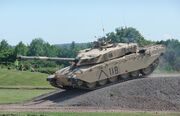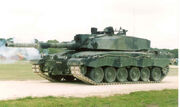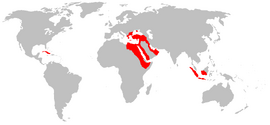Αγγίζει πάνω από όλα, και για το μέλλον (Greek) ("Soaring above all, on into the future") | |||||||
| Anthem | "March of the Legions" | ||||||
| Capital | Constantinople | ||||||
| Largest city | Constantinople | ||||||
| Language official |
Greek | ||||||
| others | Latin | ||||||
| Religion main |
Eastern Orthodox Christianity | ||||||
| others | Judaism | ||||||
| Ethnic Groups main |
Greek | ||||||
| others | Turkish, African, Middle Eastern, Jewish, Cuban | ||||||
| Demonym | Byzantine | ||||||
| Emperor | Constantine VII | ||||||
| Royal House: | Palaiologos | ||||||
| Consul | Karolos Papoulias | ||||||
| Population | 145,000,000 | ||||||
| Established | 330 | ||||||
| Currency | Solidus | ||||||
History
Creation of a New Empire
An Empire on the Rise
The Byzantines Conquer All
The Worlds' Superpower and the Byzantium Pact
A Master of the World
The Byzantine Civil War
Industrializtion and New Imperialism
The Great Wars
The Cold War
A New Era and a New World
Military
The Byzantine Empire operates the largest, and most advanced military in the world, including an army, and air force, a navy, and a space defense force. The Emperor holds the title of Supreme Commander of the Armed Forces of the Byzantine Empire, and holds dominion over the actions of the 8,000,000 men of the Byzantine Armed Forces.
Byzantine Army
The Byzantine Army operates 841 military bases in the world, both in their own borders, and in international

M21A1 Constantine V

M21A2 Constantine V
borders as well. The Army currently operates 6,000,000 men in the Byzantine Empire, and 500,000 soldiers internationally. They also operate 7,500 tanks, 10,000 IFV's, 14,000 APC's, and thousands of more necessary and vital military and engineering machines. The current Main Battle Tank is the Third-Generation M21 Constantine V, of which there are 6,000 of the 2000 model M21A1 and 1,500 of the 2007 model M21A2.
The Byzantine Army is divided into 30 Field armies, 300 corps, 600 divisions, 1,200 brigades, 6,000 battalions, 30,000 companies, 120,000 platoons, and 1,200,000 squads. The Army is under the administration of the Byzantine Department of the Army, a subdivision of the Byzantine War Department. The highest ranking Byzantine active duty officer is the Chief of the Imperial Staff, Stratarches Dimitrios Grapsas, and his highest ranking subordinate officer, is Strategos of the Byzantine Army, Erdal Ceylandoglu, the first non-Greek to hold the position.
The Byzantine Navy is the largest in the world, operating two main units, the Byzantine Coastal Defense Fleet, and the Byzantine High Seas Fleet. The Coastal Defense Fleet is made to protect the Byzantine Coast, whereas the High Seas Fleet is made to both protect the Byzantine's colonial possessions, along with performing offensive actions on the world stage. The Coastal Fleet consists of 70 coastal defense submarines, 2,000 Patrol boats of all sizes and types, and operate multiple other ship types, and hundreds of aircraft. The High Seas Fleet consists of 14 aircraft carriers, 12 amphibious assault ships, 30 cruisers, 70 destroyers, 40 frigates, and 100 submarines.
Byzantine Air Force
Byzantine Space Defense Force
Economy
The Economy of Byzantium is the second largest in the world, at an estimated 9.7 Trillion Drachma. (1 Drachma=1.2 Euro, 1.6 US Dollars) Byzantine economy comprises mostly of service sectors, leading the way in the world in the field of science, engineering, construction and one of the most influencial financial systems. The Byzantine economic policy's are one of the most progressive and innovative seen to this day.



